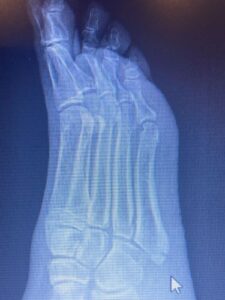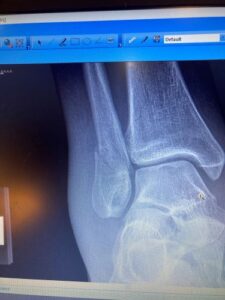Ankle sprains are one of the most common injuries, and understanding how they are classified and the best treatments for each type are essential for a quick recovery.
Most ankle sprains are inversion sprains, which involve damage to the ligaments outside the ankle. The most commonly affected ligaments are (listed in order from most common to least common): the talofibular ligament, the calcaneal talar ligament, and the posterior talofibular ligament.
Sprains are graded on a scale from 1 to 3.
- Grade 1 – Stretching of the ligament
- Grade 2 – Partial tear of at least one ligament.
- Grade 3 – Complete tear of at least one ligament.
What Are the Symptoms of an Ankle Sprain?
The first symptoms of a sprained ankle include pain, swelling, bruising, and the inability to walk normally. To minimize discomfort and promote healing, follow the RICE method. RICE stands for rest, ice, compression, and elevation. You should also take over-the-counter non-steroidal anti-inflammatory drugs (NSAID) such as Ibuprofen or Naproxen Sodium. To rule out a fracture of the foot or ankle, have a doctor perform an x-ray. You may also consider wearing a brace, a cam walking boot, and walking with crutches until the pain and swelling subside to a tolerable level. Physical therapy is often neglected once the sprain starts to heal, but it is important for regaining strength and stability in the ankle. When ligaments are sprained or torn, the ankle becomes weak and is more prone to injury if the proprioceptive nerves aren’t retrained. These nerves are in the ligaments themselves and tell the ankle to “not” twist before your brain does, or you even realize it is twisting.
Types of Fractures and Tendon Tears Associated With Ankle Sprains
Bone fractures and tendon tears are common injuries that occur with ankle sprains. Emergency rooms and urgent care facilities will perform X-rays. Specifically, a 5th metatarsal base is a common fracture in ankle sprains. If this occurs, wear a knee-high cam walking boot and crutches. These fractures are very slow to heal and often take up to three months. Surgery may be required if the fracture is displaced or separated. Either way, taking calcium and vitamin D3 supplements helps the healing process.
An ankle fracture is less common when you have a sprained ankle. But, when this does happen, it is most commonly the lateral ankle bone, or malleolus, that is fractured. Other ankle fractures are a fibula spiral fracture, a more proximal, or high, fibula fracture; a defect, or talus fracture; and a tibial, or a medial malleolus fracture. Again, if the fracture is displaced, you will need surgery. Otherwise, wearing a knee-high cam walking boot, and using crutches, is necessary for fracture healing, along with calcium and vitamin D3 supplements.
For some who sprain their ankles, the lateral, or Peroneal, tendons can also be injured at the same time. This is not typically detected until after the sprain heals. The tendons usually heal while the sprain is healing if they have been injured and the RICE protocol has been administered.
If you continue to have foot or ankle pain six weeks after the ankle sprain, you should get an MRI. The MRI will detect ligament, bone, cartilage, muscle, and tendon injury. The Peroneal Brevis and Longus are the two muscles/tendons that hug the lateral ankle bone (lateral malleolus) as they enter the foot. The Peroneal Brevis inserts, or attaches, to the 5th metatarsal base, and the Peroneal Longus wrap around the lateral to the plantar foot. Wearing a knee-high cam walking boot for four to six weeks greatly helps with the healing process. If pain is still present after six weeks, surgery is required to heal the tendon tear(s).
Ankle sprains can be painful and debilitating, but understanding the common types of foot and ankle injuries and the appropriate treatment options can help ensure a successful recovery. Always consult a medical professional for personalized advice on managing your injury and engaging in proper rehabilitation.



